How to use coding standards and static code checking plug-ins
May 06, 2021 am 09:59 AMThis article will introduce you to coding standards and how to use static code checking plug-ins. It has certain reference value. Friends in need can refer to it. I hope it will be helpful to everyone.

Alibaba Java Coding Guidelines
The first introduction is Alibaba’s coding convention, I believe everyone is familiar with this. The installation method is
settings->plugins里面搜索 Alibaba Java Coding Guidelines- >install->重啟Idea
This plug-in focuses on code defects. Detailed coding specifications have been defined in the "Alibaba Development Manual". If you are interested, you can take a look.
If you want to check all the files in the entire project, you can close the class in the window, and then press the Ctrl Alt Shift J shortcut key, or you can do the operation as shown below.

The result of the check is as shown in the figure:
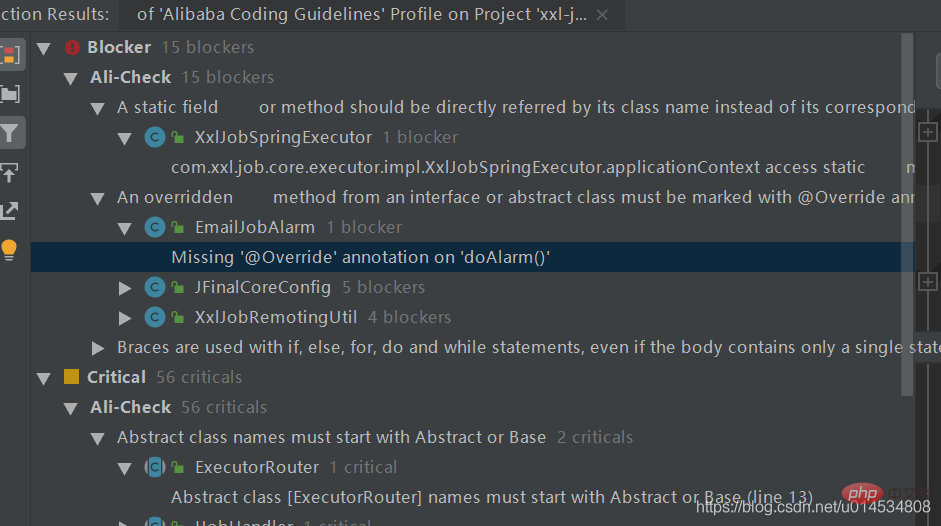
If you want to check a single file, you can right-click on the class , select Alibaba Coding Guidelines Analyze
CheckStyle
The second plug-in to be introduced is the CheckStyle plug-in. This plugin focuses on code format checking. The usage is as follows: In the checkstyle panel, click the check button to check, or you can check a single file.
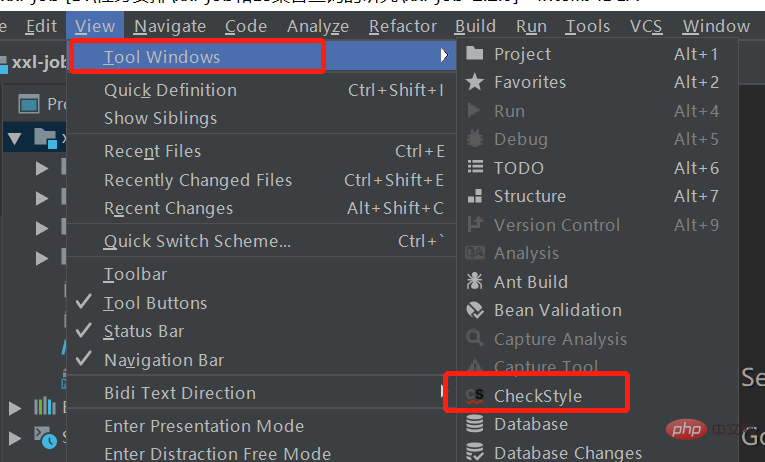
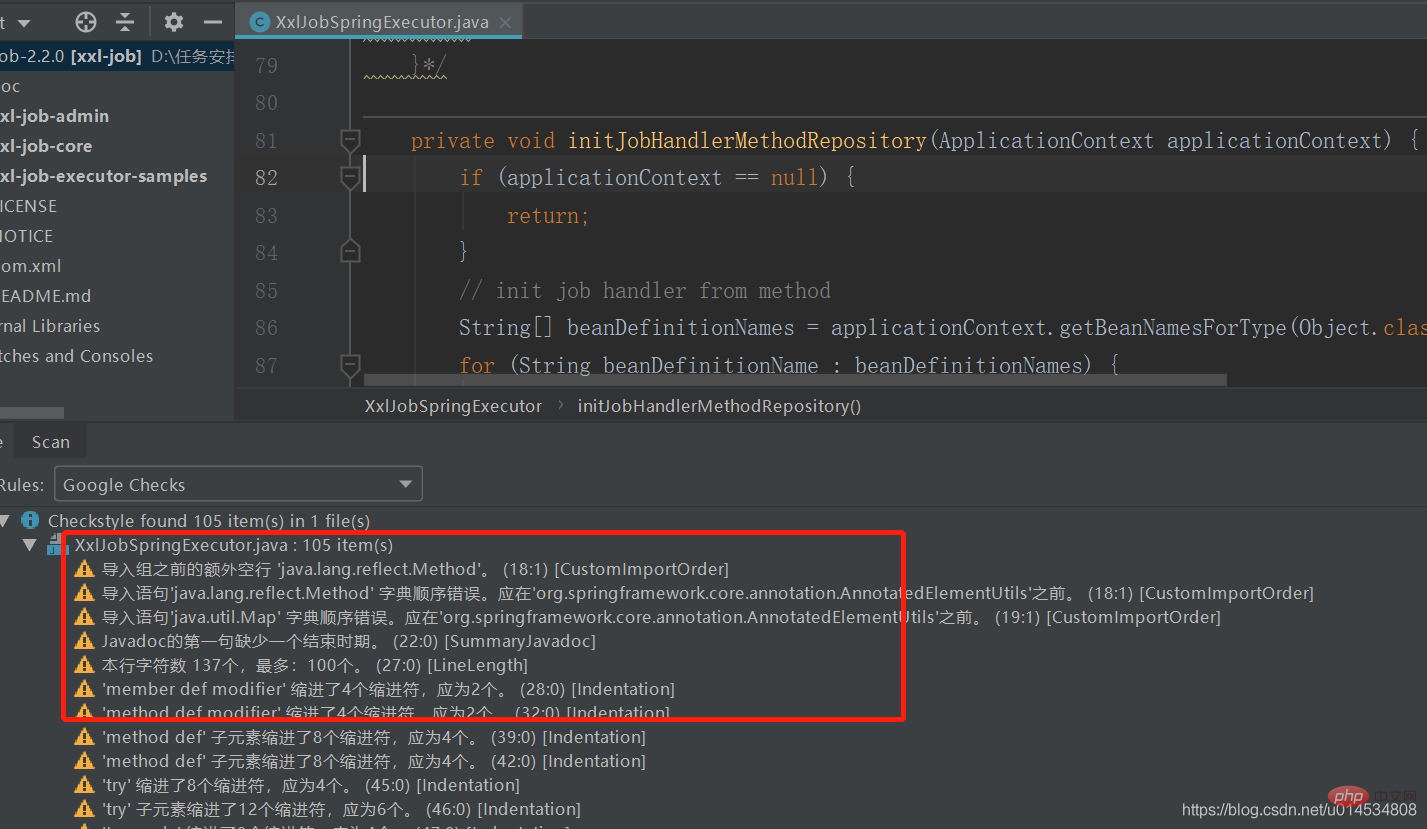
#As shown in the picture above, you can see that there are some coding standards for indentation and so on, so you don’t need to pay too much attention to them.
Findbugs
The function of findBugs-idea focuses on finding bugs that may exist in the code. It inspects a class or JAR file, comparing the bytecode to a set of defect patterns (with built-in detectors) to find possible problems. Execute Findbugs coding convention scanning PMD
(Programming Mistake Detector) is an open source static code inspection tool. PMD supports multiple languages, such as Java for the project itself, Apex and VisualForce related to Salesforce, as well as JavaScript, XML, etc. PMD has a preset set of coding rules for various languages, and also supports the development of custom rules, using Java classes or XPath.
Select a piece of code, and then right-click Run PMD->Pre Defined. There are many inspection types to choose from, including code style, design, etc.

SonarLint
The last thing I want to introduce is the SonarLint plug-in, this plug-in and the Alibaba Java Coding Guidelines plug-in These are two plug-ins that are used more frequently in actual projects. The following will introduce the installation and use of the plug-in in detail.
Installation
settings->plugins里面搜索 SonarLint >install->重啟Idea
Configure SonnarLint check address:
settings->Tools->SonarLint->Settings 中增加sonarqube的地址
Configure the address of sonarqube as shown below
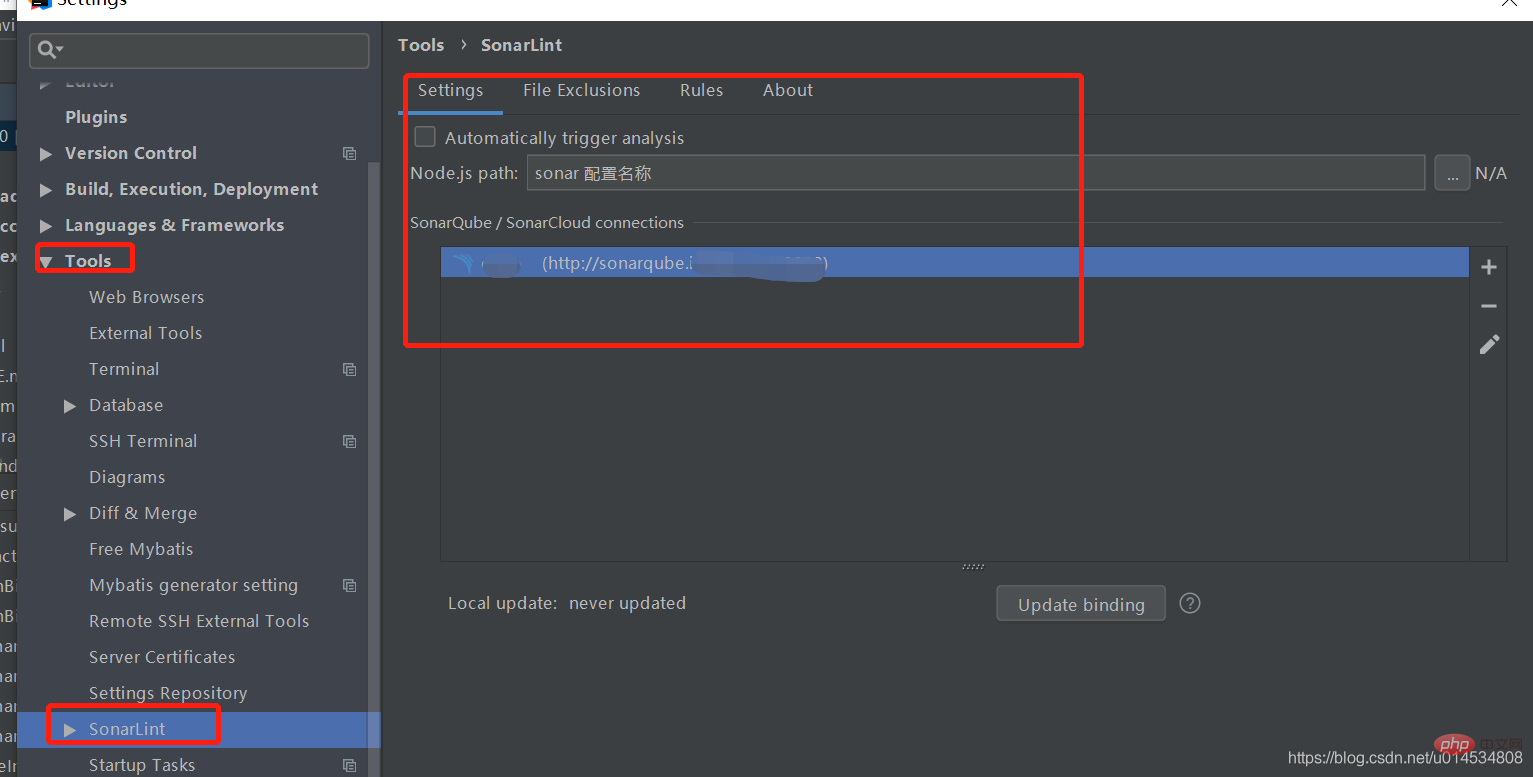
Use SonarList
After configuring SonarList, you can use it. SonarLint can check all files. The way to check all files is: click Analyze->Analyze All Files with SonarLint.

You can also check a single file. A single file is selected by right-clicking in the file editing area:
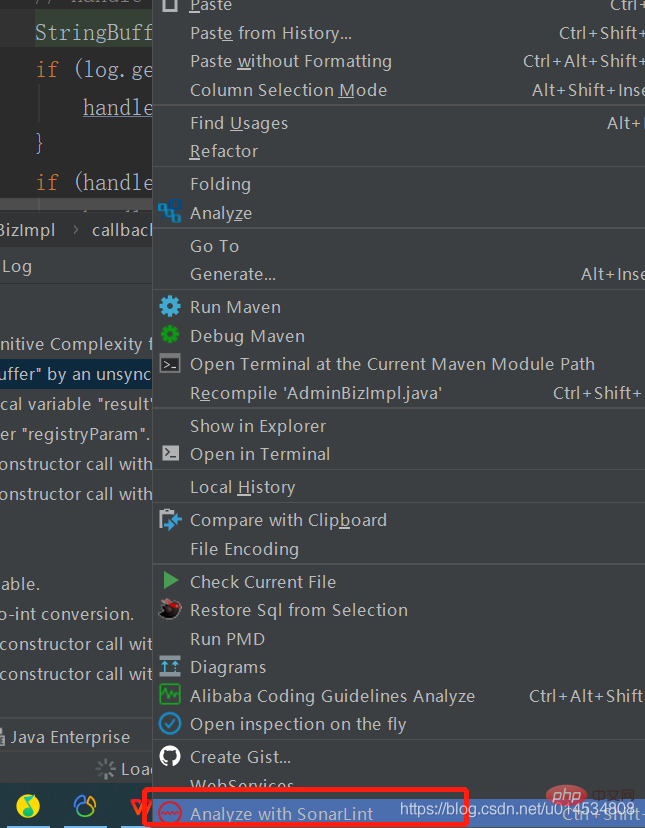
The generated report is as follows : There are both violation issues (ie potential Bugs & Vulnerabilities) here. For example: NullPointerException, which also has bad code smells (Code Smells). Generally speaking, we need to deal with bug-level problems, and bad smells can be ignored. Another indicator is the code duplication rate, that is, the repeated code within the code.

Comparison of various plug-ins
Different focus of inspection
| Tools | Analysis objects | Focus on | Application technology |
|---|---|---|---|
| Alibaba Java Coding Guidelines | Source code | Code defects | Inspection mechanism provides real-time detection function |
| CheckStyle | Source File | Format Defect | Defect Pattern Match |
| FindBugs | Bytecode | Code defects | Defect pattern matching, data flow analysis |
| PMD | Source code | Code defects | Defect pattern matching |
| SonarList | Source code | Code defect | Defect pattern matching, multiple dimensions processing |
Different check items
| Tool | Purpose | Check items |
|---|---|---|
| Alibaba Java Coding Guidelines | Scan out all potential code hazards | Method name parameter name member variable local variable enumeration class try -catch |
| CheckStyle | Check whether the Java source file is consistent with the code specification | Javadoc comment naming specification title import statement volume size blank |
| FindBugs | Based on the concept of Bug Patterns, find potential bugs in javabytecode (.class file) | NullPoint null pointer check, no unreasonable closing of resources |
| PMD | Check Java source files for potential problems | Unused local variables, empty catch blocks, unused parameters, empty if statements, repeated import statements, Unused private methods may be Singleton class short/long variables and method names |
| SonarList | Scan out all potential code hazards | Methods Name parameter name member variable local variable enumeration class try-catch |
Related free learning recommendations: java basic tutorial
The above is the detailed content of How to use coding standards and static code checking plug-ins. For more information, please follow other related articles on the PHP Chinese website!

Hot AI Tools

Undress AI Tool
Undress images for free

Undresser.AI Undress
AI-powered app for creating realistic nude photos

AI Clothes Remover
Online AI tool for removing clothes from photos.

Clothoff.io
AI clothes remover

Video Face Swap
Swap faces in any video effortlessly with our completely free AI face swap tool!

Hot Article

Hot Tools

Notepad++7.3.1
Easy-to-use and free code editor

SublimeText3 Chinese version
Chinese version, very easy to use

Zend Studio 13.0.1
Powerful PHP integrated development environment

Dreamweaver CS6
Visual web development tools

SublimeText3 Mac version
God-level code editing software (SublimeText3)
 VSCode settings.json location
Aug 01, 2025 am 06:12 AM
VSCode settings.json location
Aug 01, 2025 am 06:12 AM
The settings.json file is located in the user-level or workspace-level path and is used to customize VSCode settings. 1. User-level path: Windows is C:\Users\\AppData\Roaming\Code\User\settings.json, macOS is /Users//Library/ApplicationSupport/Code/User/settings.json, Linux is /home//.config/Code/User/settings.json; 2. Workspace-level path: .vscode/settings in the project root directory
 How to handle transactions in Java with JDBC?
Aug 02, 2025 pm 12:29 PM
How to handle transactions in Java with JDBC?
Aug 02, 2025 pm 12:29 PM
To correctly handle JDBC transactions, you must first turn off the automatic commit mode, then perform multiple operations, and finally commit or rollback according to the results; 1. Call conn.setAutoCommit(false) to start the transaction; 2. Execute multiple SQL operations, such as INSERT and UPDATE; 3. Call conn.commit() if all operations are successful, and call conn.rollback() if an exception occurs to ensure data consistency; at the same time, try-with-resources should be used to manage resources, properly handle exceptions and close connections to avoid connection leakage; in addition, it is recommended to use connection pools and set save points to achieve partial rollback, and keep transactions as short as possible to improve performance.
 python itertools combinations example
Jul 31, 2025 am 09:53 AM
python itertools combinations example
Jul 31, 2025 am 09:53 AM
itertools.combinations is used to generate all non-repetitive combinations (order irrelevant) that selects a specified number of elements from the iterable object. Its usage includes: 1. Select 2 element combinations from the list, such as ('A','B'), ('A','C'), etc., to avoid repeated order; 2. Take 3 character combinations of strings, such as "abc" and "abd", which are suitable for subsequence generation; 3. Find the combinations where the sum of two numbers is equal to the target value, such as 1 5=6, simplify the double loop logic; the difference between combinations and arrangement lies in whether the order is important, combinations regard AB and BA as the same, while permutations are regarded as different;
 Mastering Dependency Injection in Java with Spring and Guice
Aug 01, 2025 am 05:53 AM
Mastering Dependency Injection in Java with Spring and Guice
Aug 01, 2025 am 05:53 AM
DependencyInjection(DI)isadesignpatternwhereobjectsreceivedependenciesexternally,promotingloosecouplingandeasiertestingthroughconstructor,setter,orfieldinjection.2.SpringFrameworkusesannotationslike@Component,@Service,and@AutowiredwithJava-basedconfi
 python pytest fixture example
Jul 31, 2025 am 09:35 AM
python pytest fixture example
Jul 31, 2025 am 09:35 AM
fixture is a function used to provide preset environment or data for tests. 1. Use the @pytest.fixture decorator to define fixture; 2. Inject fixture in parameter form in the test function; 3. Execute setup before yield, and then teardown; 4. Control scope through scope parameters, such as function, module, etc.; 5. Place the shared fixture in conftest.py to achieve cross-file sharing, thereby improving the maintainability and reusability of tests.
 Troubleshooting Common Java `OutOfMemoryError` Scenarios
Jul 31, 2025 am 09:07 AM
Troubleshooting Common Java `OutOfMemoryError` Scenarios
Jul 31, 2025 am 09:07 AM
java.lang.OutOfMemoryError: Javaheapspace indicates insufficient heap memory, and needs to check the processing of large objects, memory leaks and heap settings, and locate and optimize the code through the heap dump analysis tool; 2. Metaspace errors are common in dynamic class generation or hot deployment due to excessive class metadata, and MaxMetaspaceSize should be restricted and class loading should be optimized; 3. Unabletocreatenewnativethread due to exhausting system thread resources, it is necessary to check the number of threads, use thread pools, and adjust the stack size; 4. GCoverheadlimitexceeded means that GC is frequent but has less recycling, and GC logs should be analyzed and optimized.
 How to work with Calendar in Java?
Aug 02, 2025 am 02:38 AM
How to work with Calendar in Java?
Aug 02, 2025 am 02:38 AM
Use classes in the java.time package to replace the old Date and Calendar classes; 2. Get the current date and time through LocalDate, LocalDateTime and LocalTime; 3. Create a specific date and time using the of() method; 4. Use the plus/minus method to immutably increase and decrease the time; 5. Use ZonedDateTime and ZoneId to process the time zone; 6. Format and parse date strings through DateTimeFormatter; 7. Use Instant to be compatible with the old date types when necessary; date processing in modern Java should give priority to using java.timeAPI, which provides clear, immutable and linear
 Understanding the Java Virtual Machine (JVM) Internals
Aug 01, 2025 am 06:31 AM
Understanding the Java Virtual Machine (JVM) Internals
Aug 01, 2025 am 06:31 AM
TheJVMenablesJava’s"writeonce,runanywhere"capabilitybyexecutingbytecodethroughfourmaincomponents:1.TheClassLoaderSubsystemloads,links,andinitializes.classfilesusingbootstrap,extension,andapplicationclassloaders,ensuringsecureandlazyclassloa






